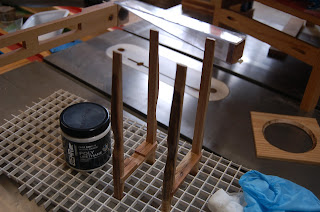With prices of lumber soaring, specially hardwoods, it's time to go to the scrap heap for a little project and try out this new gizmo. Woodworking inventors came up with another helper tool, making measuring and marking unnecessary to make this all important joinery.
A little glue-up widens the "sticks".
Hand tooling with a hand plane and scraper to smooth and flatten the surfaces.
This tool is essentially a 2-stage stop block to cut dado on two pieces to be joined, repeatably and accurately. On the table saw, acting as a stop block, it will hold the work piece while the first cut is made. Flipping it over, the stop block position now allows for the second cut. The width of the dado is now established, allowing for the next successive cuts to nibble away the rest of the cut. More importantly, this tool registers the width of the matching dadoes, in the case of the cross lap joinery. It will also register the exact width of a dado or groove where a piece of a desired dimension will snugly fit.
The small projects, on a per board foot per unit of time, take longer to do that require a little more care to execute. This tool is a time saver. And once set, the accuracy and repeatability are noteworthy.
An oscillating drum sander makes quick work of shaping the desired contour
The router table takes care of rounding over the edges
Only these two pieces will be glued jointly
These two separate parts will be held in place by the weight of the base, as in the next photo.
This non-draining planter's weight will hold the the two-piece stand. Surprisingly stable, yet will easily disassemble and back within 10 seconds.
I take this as another opportunity to show case non-draining planters for house plants. The ivy cuttings took less than 60 days to sprout a healthy root system in water. Root actually started to show in 2 weeks in water.
Another set of cuttings (different plant) showing thin root filaments that sprouted in water.
This is a combo white rock bottom base, separated from the top soil with a flow-thru liner.
Also non-draining, except it will have top potting soil over the white stones.
This new project in front of two other non-draining planters made a while back.
Below are all non-draining planters that have been doing very well.





















.jpg)



